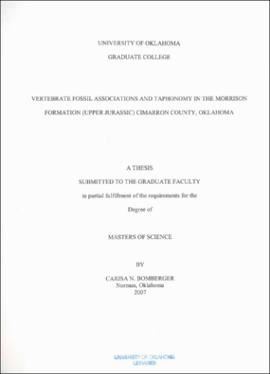| dc.contributor.author | Bomberger, Carisa Nicole | |
| dc.coverage.spatial | Morrison Formation | |
| dc.coverage.spatial | Oklahoma | |
| dc.coverage.spatial | Cimarron County | |
| dc.coverage.spatial | Morrison Formation | |
| dc.coverage.spatial | Oklahoma | |
| dc.coverage.spatial | Cimarron County | |
| dc.date.accessioned | 2022-05-30T17:00:14Z | |
| dc.date.available | 2022-05-30T17:00:14Z | |
| dc.date.created | 2007 | |
| dc.date.issued | 2007 | |
| dc.identifier.uri | https://hdl.handle.net/11244/335843 | |
| dc.description | Thesis (M.S.)--University of Oklahoma, 2007. | |
| dc.description | Includes bibliographical references (leaves 62-71). | |
| dc.description.abstract | The purpose of this project is to evaluate fossil distribution within three dinosaur quarries in the Morrison Formation, excavated in the 1940s, in the panhandle of Oklahoma. The sedimentology and stratigraphy of the Morrison of Cimarron County, Oklahoma, is similar to the Brushy Basin Member in the Morrison Formation of Colorado, with the varicolored jointed clays that are common within this member.
By examining the digitized versions of the original quarry maps for each of quarries 5, 6, and 8, an attempt was made to associate skeletal elements as belonging to a single individual based on their proximity to other bones of the same taxon and the skeletal elements represented. Comparisons were also made between the faunas, amount of articulated bones, and fossil preservation patterns of the three quarries.
It was possible to associate different skeletal parts as belonging to single individuals in each of the three quarries studied. The distribution of fossils within each of the quarries was in clumps, though in some quarries it was more scattered than others. The ability to associate different bones on the quarry maps led to a reevaluation of numerous fossils. These specimens were identified to a finer taxonomic level based on
both their proximity to other fossils in the quarry and on a reexamination of the specimens themselves. Patterns seen on the maps affected the ease with which fossil associations could be made. These patterns are caused by the depositional environments of each quarry. These depositional environments are floodplain deposits (Quarry 5 and 6) and a pond environment (Quarry 8). | |
| dc.format.extent | xii, 147 leaves | |
| dc.format.medium | xii, 147 leaves : ill. (some col.), maps (some col.) ; 29 cm. +1 CD-ROM (4 3/4 in.) | |
| dc.language.iso | eng | |
| dc.subject.lcsh | Vertebrates, Fossil--Morrison Formation | |
| dc.subject.lcsh | Vertebrates, Fossil--Oklahoma--Cimarron County | |
| dc.subject.lcsh | Taphonomy--Morrison Formation | |
| dc.subject.lcsh | Taphonomy--Oklahoma--Cimarron County | |
| dc.title | Vertebrate fossil associations and taphonomy in the Morrison Formation (Upper Jurassic), Cimarron County, Oklahoma | |
| dc.type | Text | |
| dc.contributor.committeeMember | Czaplewski, Nicholas J. | |
| dc.contributor.committeeMember | Westrop, Stephen R. | |
| dc.contributor.committeeMember | Cifelli, Richard L. | |
| ou.group | Conoco Phillips School of Geology and Geophysics | |
